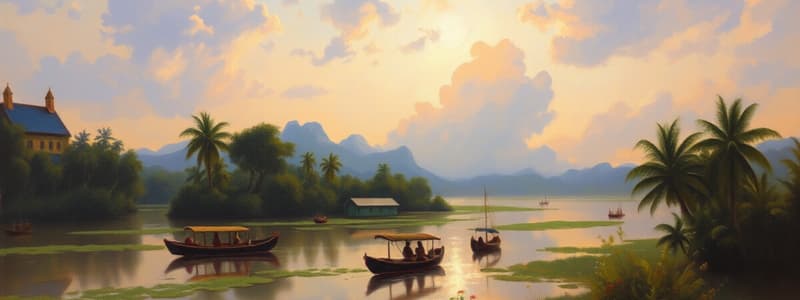Podcast
Questions and Answers
What are the three main geographical areas of the Philippines?
What are the three main geographical areas of the Philippines?
Luzon, Visayas, and Mindanao.
Describe the influence of colonial history on Filipino culture.
Describe the influence of colonial history on Filipino culture.
Filipino culture is shaped by Spanish, American, Malay, and Chinese influences due to over 300 years of Spanish colonization and subsequent American rule.
What is the primary basis for the Filipino language?
What is the primary basis for the Filipino language?
The Filipino language is based on Tagalog.
Identify two key agricultural products of the Philippines.
Identify two key agricultural products of the Philippines.
Signup and view all the answers
Who is a notable literary figure in Filipino history and why is he significant?
Who is a notable literary figure in Filipino history and why is he significant?
Signup and view all the answers
What are some challenges faced by the Philippines today?
What are some challenges faced by the Philippines today?
Signup and view all the answers
How is the government of the Philippines structured?
How is the government of the Philippines structured?
Signup and view all the answers
List two popular Filipino dishes and their primary ingredients.
List two popular Filipino dishes and their primary ingredients.
Signup and view all the answers
Study Notes
Definition
- Filipino refers to both the people of the Philippines and the national language of the country.
Ethnicity and Culture
- The Philippines is home to over 100 ethnic groups.
- Major ethnic groups include Tagalog, Cebuano, Ilocano, Visayan, and Moro.
- Influences from Malay, Chinese, Spanish, and American cultures shape Filipino identity.
- Predominantly Roman Catholic, with significant Muslim and indigenous communities.
Language
- Filipino is based on Tagalog and serves as the national language.
- English is an official language and widely used in government and education.
- There are over 175 languages spoken across the islands.
Geography
- Comprises over 7,000 islands, divided into three main geographical areas: Luzon, Visayas, and Mindanao.
- Rich biodiversity with tropical climate, mountains, and coastal regions.
History
- Colonized by Spain for over 300 years (1565-1898).
- Briefly colonized by the United States after the Spanish-American War.
- Gained independence on July 4, 1946.
Economy
- Mixed economy with agriculture, manufacturing, and services sectors.
- Key industries include electronics, agriculture (rice, coconuts), and tourism.
Arts and Literature
- Rich tradition in music, dance, and visual arts.
- Notable literary figures include José Rizal, who is a national hero.
Cuisine
- Diverse and flavorful, often includes rice, seafood, and meat dishes.
- Popular dishes: Adobo, Sinigang, Lechon, and Pancit.
Government
- Democratic republic with a presidential system.
- Divided into 17 regions, further subdivided into provinces, cities, and municipalities.
Challenges
- Issues include poverty, political instability, and natural disasters such as typhoons and earthquakes.
- Ongoing efforts for economic development and social reform.
Definition
- "Filipino" designates both the people of the Philippines and the national language spoken in the country.
Ethnicity and Culture
- The Philippines is home to over 100 distinct ethnic groups, contributing to a rich cultural tapestry.
- Major ethnic groups include Tagalog, Cebuano, Ilocano, Visayan, and Moro.
- Filipino identity is influenced by Malay, Chinese, Spanish, and American cultures, creating a unique multicultural society.
- The predominant religion is Roman Catholicism, alongside significant Muslim and indigenous communities.
Language
- Filipino, based on Tagalog, serves as the national language and is a cornerstone of national identity.
- English is an official language, extensively used in government proceedings and educational institutions.
- The country boasts over 175 languages, showcasing its linguistic diversity.
Geography
- The Philippines consists of more than 7,000 islands, categorized into three primary geographical regions: Luzon, Visayas, and Mindanao.
- It features rich biodiversity, a tropical climate, and diverse landscapes including mountains and coastal regions.
History
- The Philippines experienced over 300 years of Spanish colonization from 1565 to 1898.
- Following the Spanish-American War, the U.S. briefly colonized the Philippines.
- The nation achieved independence on July 4, 1946, marking the end of colonial rule.
Economy
- The economy is mixed, encompassing agriculture, manufacturing, and services.
- Key industries include electronics, agriculture (notably rice and coconuts), and growing tourism sectors.
Arts and Literature
- The Philippines has a vibrant tradition in music, dance, and visual arts, reflective of its diverse culture.
- José Rizal stands out as a notable literary figure and national hero, symbolizing the country's fight for independence.
Cuisine
- Filipino cuisine is known for its diversity and rich flavors, often centering around rice, seafood, and various meat dishes.
- Popular traditional dishes include Adobo (marinated meat), Sinigang (sour soup), Lechon (roasted pig), and Pancit (noodles).
Government
- The Philippines operates as a democratic republic with a presidential system.
- It is organized into 17 regions, which are further divided into provinces, cities, and municipalities.
Challenges
- The country faces significant challenges, including poverty, political instability, and natural disasters such as typhoons and earthquakes.
- There are ongoing efforts aimed at economic development and implementing social reforms to address these issues.
Studying That Suits You
Use AI to generate personalized quizzes and flashcards to suit your learning preferences.
Description
Explore the vibrant culture and geography of the Philippines through this quiz. Discover the major ethnic groups, languages spoken, and the historical influences that shape Filipino identity. Test your knowledge on the country's rich biodiversity and its geographical divisions.




